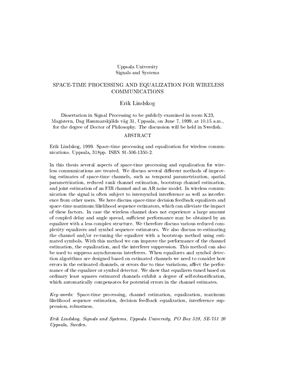Диссертация, Uppsala University, 1999, -335 pp.
In this thesis several aspects of space-time processing and equalization for wireless communications are treated. We discuss several different methods of improving estimates of space-time channels, such as temporal parameterization, spatial parameterization, reduced rank channel estimation, bootstrap channel estimation, and joint estimation of an FIR channel and an AR noise model. In wireless communication the signal is often subject to intersymbol interference as well as interference from other users. We here discuss space-time decision feedback equalizers and space-time maximum likelihood sequence estimators, which can alleviate the impact of these factors. In case the wireless channel does not experience a large amount of coupled delay and angle spread, sufficient performance may be obtained by an equalizer with a less complex structure. We therefore discuss various reduced complexity equalizers and symbol sequence estimators. We also discuss re-estimating the channel and/or re-tuning the equalizer with a bootstrap method using estimated symbols. With this method we can improve the performance of the channel estimation, the equalization, and the interferer suppression. This method can also be used to suppress asynchronous interferers. When equalizers and symbol detection algorithms are designed based on estimated channels we need to consider how errors in the estimated channels, or errors due to time variations, affect the performance of the equalizer or symbol detector. We show that equalizers tuned based on ordinary least squares estimated channels exhibit a degree of self-robustification, which automatically compensates for potential errors in the channel estimates.
Space-Time Processing in Wireless Communication
Channel Estimation
Space-Time Decision Feedback Equalization
Space-Time ML Sequence Estimation
Reduced Complexity Space-Time Equalization
Bootstrap Equalization and Interferer Suppression
Robust Equalization
In this thesis several aspects of space-time processing and equalization for wireless communications are treated. We discuss several different methods of improving estimates of space-time channels, such as temporal parameterization, spatial parameterization, reduced rank channel estimation, bootstrap channel estimation, and joint estimation of an FIR channel and an AR noise model. In wireless communication the signal is often subject to intersymbol interference as well as interference from other users. We here discuss space-time decision feedback equalizers and space-time maximum likelihood sequence estimators, which can alleviate the impact of these factors. In case the wireless channel does not experience a large amount of coupled delay and angle spread, sufficient performance may be obtained by an equalizer with a less complex structure. We therefore discuss various reduced complexity equalizers and symbol sequence estimators. We also discuss re-estimating the channel and/or re-tuning the equalizer with a bootstrap method using estimated symbols. With this method we can improve the performance of the channel estimation, the equalization, and the interferer suppression. This method can also be used to suppress asynchronous interferers. When equalizers and symbol detection algorithms are designed based on estimated channels we need to consider how errors in the estimated channels, or errors due to time variations, affect the performance of the equalizer or symbol detector. We show that equalizers tuned based on ordinary least squares estimated channels exhibit a degree of self-robustification, which automatically compensates for potential errors in the channel estimates.
Space-Time Processing in Wireless Communication
Channel Estimation
Space-Time Decision Feedback Equalization
Space-Time ML Sequence Estimation
Reduced Complexity Space-Time Equalization
Bootstrap Equalization and Interferer Suppression
Robust Equalization

